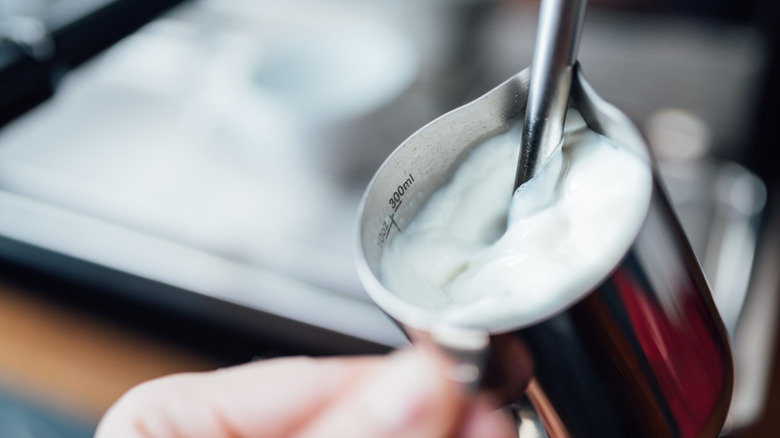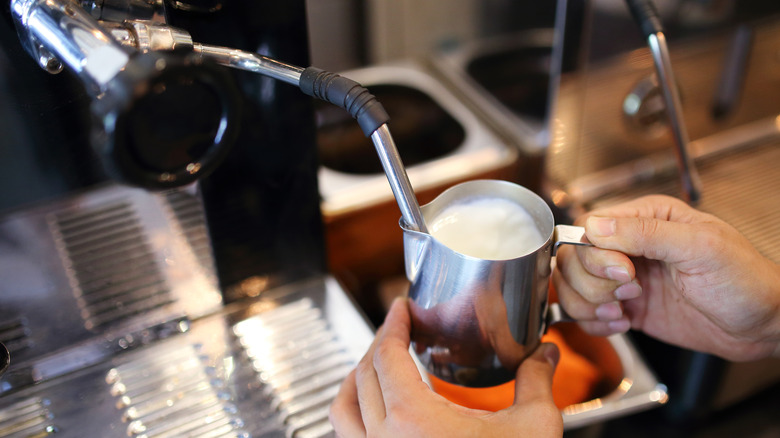The Biggest Mistakes You're Making When Steaming Milk For Coffee
If you've ever bought a shiny new coffee machine or been gifted one, you know that using the seemingly simple steaming wand to froth milk is easier said than done. A steaming wand is supposed to pump air and bubbles into your milk while gently warming it up at the same time to create foam (via The Spruce Eats). As air is added to milk, its texture goes from flat to a delicious velvety feel, similar to that of melted ice cream.
The entire process is supposed to be simple and easy, but let's admit it, several things can go wrong along the way. The milk can get boiling hot instead of warm, and with barely any change in texture if you don't do the steaming right. Not to mention, many people on Reddit complain that steaming milk often gives off a screeching sound reminiscent of dragging fingernails on a blackboard — or even worse.
Coffee expert and YouTuber James Hoffmann says that the biggest mistake you're making when steaming milk for coffee lies with your technique (via YouTube). He gives the details that will help with your technique, putting you well on your way to making thick and creamy cappuccinos and lattes!
Adding too much or too little milk can be problematic
According to coffee expert James Hoffmann's step-by-step video to steaming the perfect frothy milk, the biggest mistake that you're most likely making is not using the right amount of milk for the size of your steel warming cup. Using a small amount of milk in the steel jug or using too much for the container's size will only make it more difficult to steam the milk properly. The most you should ever fill the cup is up to the start of the spout line. This is because, as you start steaming, your milk will get more voluminous and take up space. Coupled with the swirling that drives the milk up against the jug's walls, if you use too much milk, it could result in a messy spill or not give it enough room to puff up.
Use too little milk and can be equally problematic. The liquid will spin more wildly than the controlled way in which you want it to, which will create more bubbles than is ideal (via Coffee Brothers). Additionally, the milk will also heat up more quickly, which won't give you enough time to add air to make it silky.
You always want to use fresh milk
Steaming milk essentially creates a nice and velvety foam, which comes from the protein and fat that is present in milk (via Full Coffee Roast). This is why, whole milk with a higher protein and fat content makes thicker foam as compared to the light foam that is more likely with skim milk.
The dairy product also contains glycerol, which increases as the milk ages. Glycerol breaks down the protein and, as such, milk with more glycerol will be harder to foam. This is also why using fresh, cold milk is better for frothing than using room temp milk or one that's close to its expiration date.
Coffee expert James Hoffmann explains in his video that milk with high amounts of glycerol will create a fizzing sound as soon as you stop steaming it, which comes from the bubbles popping. Sometimes, he adds, the problem could simply be in the way the milk was handled through the supply chain process, causing the milk to not foam as you would like it to, despite it being fresh and stored correctly. In such cases, although the milk will taste fine, it's simply not going to foam and you're better off buying another jug to try.
Angling the steaming wand correctly is important
Proper usage of the steaming wand is also important. If you're hearing that loud screeching sound, the problem is likely in how deep your steaming wand is inside the milk. If the tip of the wand is too deep, in addition to creating that unpleasant sound, you won't get the swirling vortex that gives the milk the creamy foam that you want for your latte (via Whole Latte Love). If you're not inserting the wand deep enough, however, you'll only get large bubbles in the milk instead of the tiny ones that you need.
Coffee pro James Hoffmann also suggests angling the streaming wand so that it sits in the nook of the spout inside the steel jug (via his YouTube video). Next, you want the wand to only go as deep as the line of the joint that connects the wand's tip to the rest of the wand. To get the milk swirling, hold the jug at a 20-degree angle tilted either towards the left or the right side (via Coffee Brothers). Tilting the jug will help the milk swirl without you having to break a sweat and produce the perfect drink.



